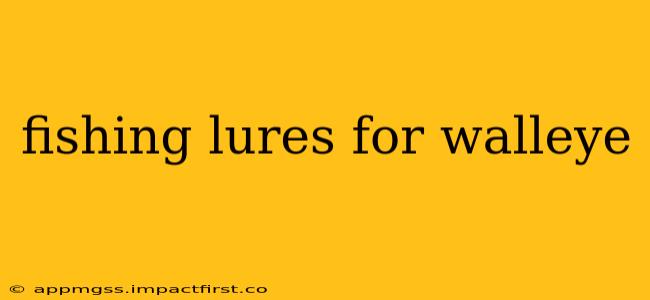Walleye, prized for their delicious flesh and challenging fight, are a favorite target for anglers across North America. Catching these elusive fish requires understanding their feeding habits and employing the right lures. This guide explores effective walleye lures, covering various types, techniques, and considerations for maximizing your success on the water. We'll delve into what makes a lure successful, and answer your burning questions about which lures work best in different conditions.
What are the best lures for walleye fishing?
The "best" lure depends heavily on the specific conditions—water clarity, depth, time of year, and walleye activity. However, certain lure types consistently prove effective. Top contenders include:
-
crankbaits: These versatile lures mimic baitfish and can be fished at various depths, making them suitable for many situations. Deep-diving crankbaits are excellent for targeting walleye holding deep, while shallow-running models are ideal for shallower water. Look for crankbaits with a strong wobble and lifelike colors that imitate common walleye prey.
-
jigs: Jigs are incredibly effective, particularly when tipped with live bait like minnows or leeches. The jig's weight allows for precise casting and bottom contact, while the live bait adds irresistible action. Experiment with different jig sizes and colors to find what works best in your fishing spot.
-
spinnerbaits: These lures combine a spinner blade with a jig or plastic trailer, creating flash and vibration that attracts walleye. Spinnerbaits are particularly effective in murky or stained water where the flash helps the lure stand out.
-
soft plastics: These versatile lures are incredibly effective, especially when rigged on jigs or Texas-rigged. They come in various shapes and sizes, mimicking various baitfish. Tubes, grubs, and swimbaits are popular choices for walleye.
-
spoons: Spoons are classic walleye lures that create an enticing flash and vibration. They are particularly effective when retrieved with a erratic action.
What color lures work best for walleye?
Walleye eyesight is adapted to low-light conditions, so lure color is less critical than action and presentation in many cases. However, some colors consistently perform well:
-
natural colors: Colors imitating baitfish like shad (silver, white, or chartreuse) and perch (gold, yellow, or orange) are often highly effective.
-
glow-in-the-dark: These lures are especially effective at night or in deep, dark water.
-
UV reactive: These lures contain pigments that glow under ultraviolet (UV) light, adding an extra dimension of attraction for walleye.
Ultimately, experimentation is key. The best color can vary depending on water clarity, time of day, and prey availability.
What size lures are best for walleye?
The ideal lure size depends on the size of the walleye you're targeting and the size of their primary food source. Generally:
-
Smaller lures (1/8 - 1/4 oz): These are effective for catching smaller walleye or when walleye are feeding on smaller baitfish.
-
Medium lures (1/4 - 3/8 oz): These are versatile and work well in a variety of situations.
-
Larger lures (3/8 oz and up): These are best used for targeting trophy-sized walleye or when fish are actively feeding on larger prey.
What type of line is best for walleye fishing?
Choosing the right line is crucial for successful walleye fishing. Braided line offers excellent sensitivity and strength, allowing you to feel subtle bites and set the hook effectively. However, it can be more visible in clear water. Monofilament line is less visible but offers less sensitivity. Fluorocarbon line offers a good compromise between visibility and sensitivity. Consider the water clarity and your preferred fishing style when selecting your line.
What retrieves work best for walleye fishing?
Varying your retrieve is essential for enticing bites. Experiment with different speeds and actions:
-
slow and steady: This retrieve works well when walleye are less aggressive.
-
stop and go: This technique involves short bursts of reeling followed by pauses, mimicking injured or fleeing baitfish.
-
twitching: Rapid twitches of the rod tip can trigger strikes from aggressive walleye.
The best retrieve will depend on the specific lure and the walleye's mood.
When is the best time to fish for walleye?
Walleye are most active during low-light conditions, such as dawn and dusk. They are also known to feed actively at night. However, consistent success requires understanding seasonal patterns and specific lake conditions.
This comprehensive guide offers a strong foundation for choosing and using effective walleye lures. Remember, consistent success requires adapting to conditions, experimenting with different techniques, and always respecting the environment. Happy fishing!
